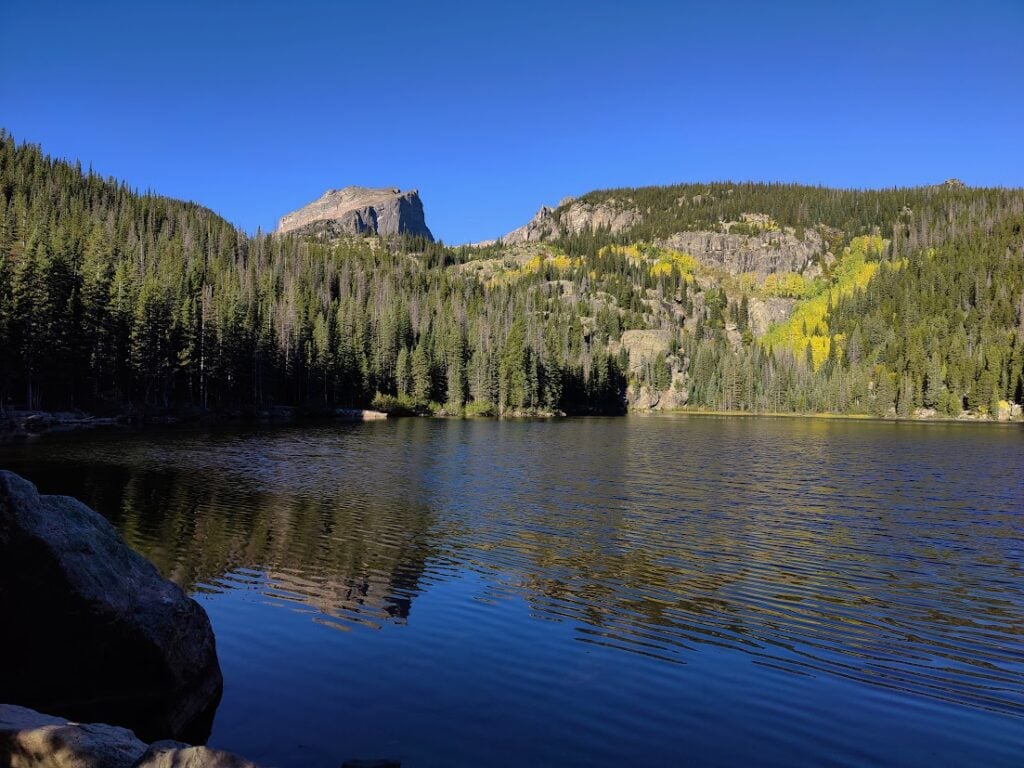
Bear Lake Road, aka the Bear Lake Corridor, is the most popular of Rocky Mountain National Park. It’s so popular that Rocky Mountain’s timed-entry reservation options include one just for this area during the height of the visitation season. Despite seasonal crowding, this is truly a must-see area of Rocky Mountain; it’s rich with history and encompasses all life zones protected within its boundaries.
This piece can serve as a complete guide to visiting the Bear Lake Corridor in all seasons. It will include tips for avoiding crowds, safety information, logistics, and hiking recommendations for those of all fitness levels. If there is only one area of Rocky Mountain to visit, this place has something for everyone and it includes some of the most dramatic vistas in the Park.
One of the best features of the Bear Lake Corridor is the front-country accessibility to remote, high-altitude locations. I have been exploring the area for decades, with friends and family of all ages, and I still encounter new hikes, pull-outs, and views to experience and photograph. Read on to learn about my specific recommendations and get insider tips for visiting Bear Lake Road in all seasons.
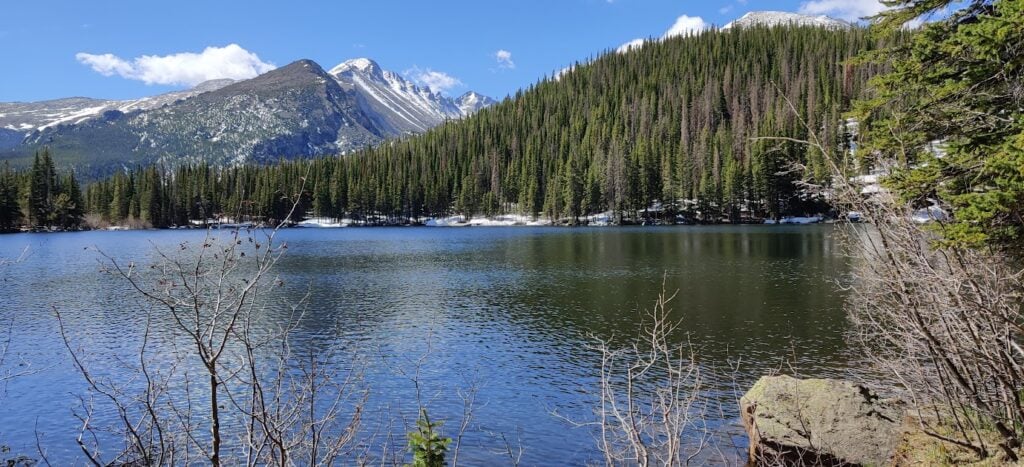
VISITING ROCKY MOUNTAIN AND NEED A GAME PLAN? CHECK OUT OUR ITINERARY.
Bear Lake Road is less than 10 miles long, one way, and is an up-and-back drive with many pullouts, side destinations, and options for hikers of all abilities.
The Bear Lake Corridor includes Moraine Park and the much smaller Hollowell Park. If you are a hiker, these parks will be a treat for you! The RMNP map below shows the trail system connecting and looping through the area.
The next stop is the Park and Ride which serves as a hub for Rocky Mountain’s free shuttle system. If you are visiting in the summer, I seriously advise you to pause here to make a decision. From the end of May through September, when the traffic is terrible, the Park and Ride offers a viable way to travel the entire Bear Lake Corridor, with stops at trailheads and campgrounds.
As you travel higher, there will be trailhead access to a series of sub-alpine and alpine natural lakes that dot the eastern edge of the Continental Divide. These picturesque, small bodies of water are filled with glacial melt and offer stunning views for those hardy enough to hike up to them.
But never fear, there are lakes you can drive right up to, including the corridor’s namesake: Bear Lake. This will be explained in detail later but first, I will dive a little bit into the development of the Bear Lake Corridor, long before anyone ever dreamed of creating a national park.
READ: Driving in Rocky Mountain National Park: 10 Things to Know
It’s a tale of homesteaders and hoteliers: Moraine Park was developed with resorts, a post office, markets, and even a 9-hole golf course. It contained Abner Sprague’s first homestead, which he sold to a man named Stead before building a more rustic and remote hotel, with a private lake for fishing. Sprague Lake is the only manmade lake in this area that remains. By the mid-1960s, most of the buildings were razed to preserve the natural habitat and make the area safer for road travel, which was quickly gaining popularity in this country after World War II. Pull-outs, parking lots, and campgrounds were established.
It’s helpful to understand why this area has always been so popular. For nearly 200 years the Bear Lake Corridor has attracted crowds; and for thousands of years before that, the area has been sacred to indigenous people. Keep reading for my recommendations for navigating this corridor.
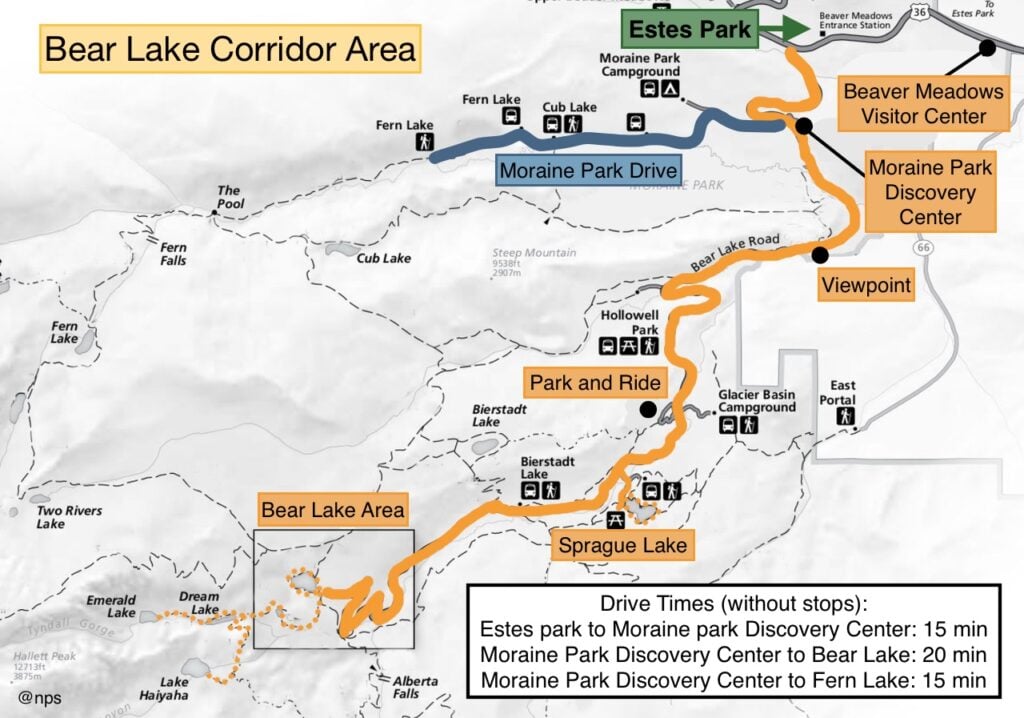
Guide includes reservation requirements, driving tips, and things to do along the way.
Timed-entry reservations are required from about the end of May through October. See the National Park website for exact dates. Each reservation is for a 2-hour window for entry, starting at 5 a.m. and ending at 6 p.m. This reservation is called the Timed Entry + Bear Lake Road and reservations can be made as early as May 1 for the first day reservations are needed to visit the area. However, for seven months of the year, reservations are not needed to visit the Bear Lake Corridor and frankly, these are my favorite times to go.
The entire Bear Lake Corridor is above 8,500 feet, so altitude sickness may be a concern. Even though I’ve lived above 7,000 feet in altitude for decades, sometimes I can get a headache at higher altitudes. An electrolyte drink cures this for me; be sure to bring lots of water and/or hydration beverages with electrolytes – and maybe even supplemental oxygen if you think you might have issues with altitude sickness.
The terrain along the Bear Lake Corridor varies greatly. There are nice strolls around Sprague Lake and Bear Lake as well as hiking destinations that will challenge you. In short, there’s something for everyone so don’t be afraid to explore!
DISCOVER: Four Spectacular Rocky Mountain Road Trips.
Although Bear Lake freezes over completely in the depths of winter, in the shoulder seasons (October-December and April-May), it could be dangerous to try and walk on Bear Lake, even if it’s covered in snow.
Swimming is not allowed at Bear Lake or Sprague Lake but is at the higher alpine lakes.
I make sure to wear proper footwear and take traction devices and trekking poles with me in all seasons while visiting this corridor. Storms can move in quickly in the mountains, so bring layers and raingear. Check out our recommended gear page for more.
Your vehicle must have proper tires when Rocky Mountain declares the state’s Traction Law is in effect. You could be cited if Park Rangers need to pull your vehicle out of a ditch if you don’t have the proper tires during these times! If you are not used to driving in winter conditions, a drive on Bear Lake Road is not the place to practice!
Never approach wildlife (even for a good picture) in Rocky Mountain! These animals can be unpredictable and it is illegal to feed them.
Yes, you can visit the Bear Lake Corridor in the height of summer if you don’t have a reservation, you just need to either get in before 5 a.m. or after 6 p.m. You can watch the sunrise at Sprague Lake and the afternoon sun glisten on Dream Lake during these times.
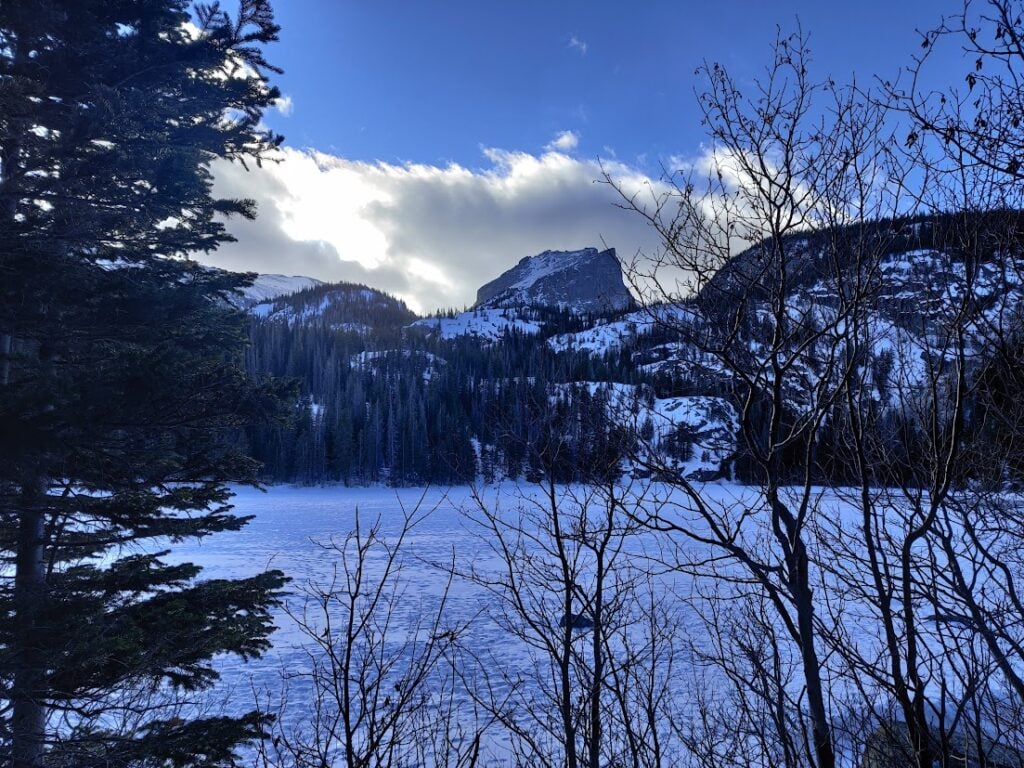


In the lower elevations of the Bear Lake Corridor, you will find parks that were created by the recession of glaciers after the last ice age. These are strikingly level areas that are surrounded by hills and peaks, the meadows are dotted with boulders formed deep underground and then revealed during the glaciation process.
From this part of the Bear Lake Corridor, you can access trailheads if you want to go on a hike and there are many areas to pull off and have a picnic. Moraine Park Campground is an amazing place to camp! There is access to all the trailheads in Moraine Park and you can even get a ride on the Park and Ride to visit other areas in the corridor.
Backcountry camping is available year-round with a Wilderness Permit. These permits are issued through receation.gov and are usually available beginning on March 1st every year.
Walk-up wilderness permits can be obtained for winter camping at the Wilderness Office of Rocky Mountain, located on the east side of the Park adjacent to the Beaver Meadows Visitor Center. Kid-friendly and handicapped sites are included in these back-country sites, so explore the possibilities carefully when making your reservations. Find out more in our article 11 Best Campgrounds In and Around Rocky Mountain National Park.
There are two major trailheads at the back of Moraine Park: Cub Lake and Fern Lake, both of which are fairly well-traveled during the summer and fall. These iconic destinations, as well as the subalpine and alpine lakes, can all be reached through loop hiking from Hollowell Park, too. Taking circuitous routes through this area can increase or decrease the length and difficulty of the trek, which is another reason this area is so popular for hiking.
| Hikes from Moraine Park | Distance | Level |
| Cub Lake | 5.3 miles out and back | Moderate |
| Fern Lake | 7.5 miles out and back | Moderate |
| Moraine Park Loop (cuts through the campground when open) | 3.3 mile loop | Moderate |
Just stopping for a picnic? No problem, there are picnic tables dotted throughout Moraine Park and at the Hollowell Park trailhead as well as a dedicated picnic area, Tuxedo Park.
These meadows are full of flowers from late June through September and are great places to watch elk and moose, seasonally. In Moraine Park, the Big Thompson River meanders through the valley, creating lush ecosystems that are very attractive to wildlife.



Moving a bit further up Bear Lake Road, you’ll come to the pull-out for the Glacier Basin Campground on the left side of the street. This beautiful campsite is open seasonally, from May to the beginning of September. These two developed campsites can be reserved using Recreation.gov.
The Bierstadt Lake trailhead is just after the Park and Ride, but I’ve got another option for you to make this hike a bit easier. Take the shuttle to Bear Lake and start walking around the Bear Lake Nature Trail, to the right. Hike the Flattop Mountain Trail to the turnoff for Bierstadt Lake. When you get to the lake, walk around it to see amazing views, and maybe even a moose! The trail that winds around the lake hooks up to the Bierstadt Lake trail, which descends with steep switchbacks back to the Park and Ride lot. It’s so much easier to hike switchbacks when you’re going downhill!
The Park and Ride in the Bear Lake Corridor is a very viable option at the height of the visitation season. Parking fills up very early at Bear Lake, which is the main parking lot; if you don’t get there by 8:00 am, you’re going to be turned back. Shuttles run very often in the summer and fall and can be reliably counted on when traffic and visitation are very high.
Other transportation options to reach the Park and Ride hub include the Hiker’s Shuttle, which leaves from the Estes Park Visitor Center to connect with Rocky Mountain’s shuttle system at the Park and Ride. The Estes Park Visitor Center has a three-story parking garage with free parking.
An amazing regional transportation option is taking the state’s Bustang service, which also runs seasonally. With stops starting in Denver and traveling north up to Estes Park, you can pick up the Bustang anywhere along the line and be in the Bear Lake Corridor by mid-morning. Find out more information in our article A Complete Guide to Shuttles in Estes Park and Rocky Mountain.
In the late fall through spring, shuttles don’t operate so driving your car up to Bear Lake is your only option.
DISCOVER: Which is the Best Entrance to RMNP?



Sprague Lake was created by Abner Sprague who built a lodge (no longer standing) and wanted to provide fishing opportunities for his guests. This is the next spot you’ll come to along the Bear Lake Corridor. It also has a large parking lot, which doesn’t tend to fill up so this is where I like to park during the summer (unless I’m taking a shuttle).
The wheelchair-accessible stroll around the lake is a great way to get a taste of a subalpine lake without having to hike to it! There is also a handicapped-accessible wilderness camp spot (see above) that can truly immerse you into the wilds of the area while being only a short jaunt from the trail.
This lake has stunning views of the Continental Divide and is a popular spot for wedding photography.
Other activities include fishing; Sprague Lake is one of the “catch and keep” areas for fishing; but a valid Colorado fishing license for those 16 years old is required. There are also strict regulations about using bait while fishing. Please review this page of fishing regulations carefully before you start fishing in any body of water in Rocky Mountain. Please note: fishing is strictly prohibited at Bear Lake, including 200 yards upstream and downstream from the lake.
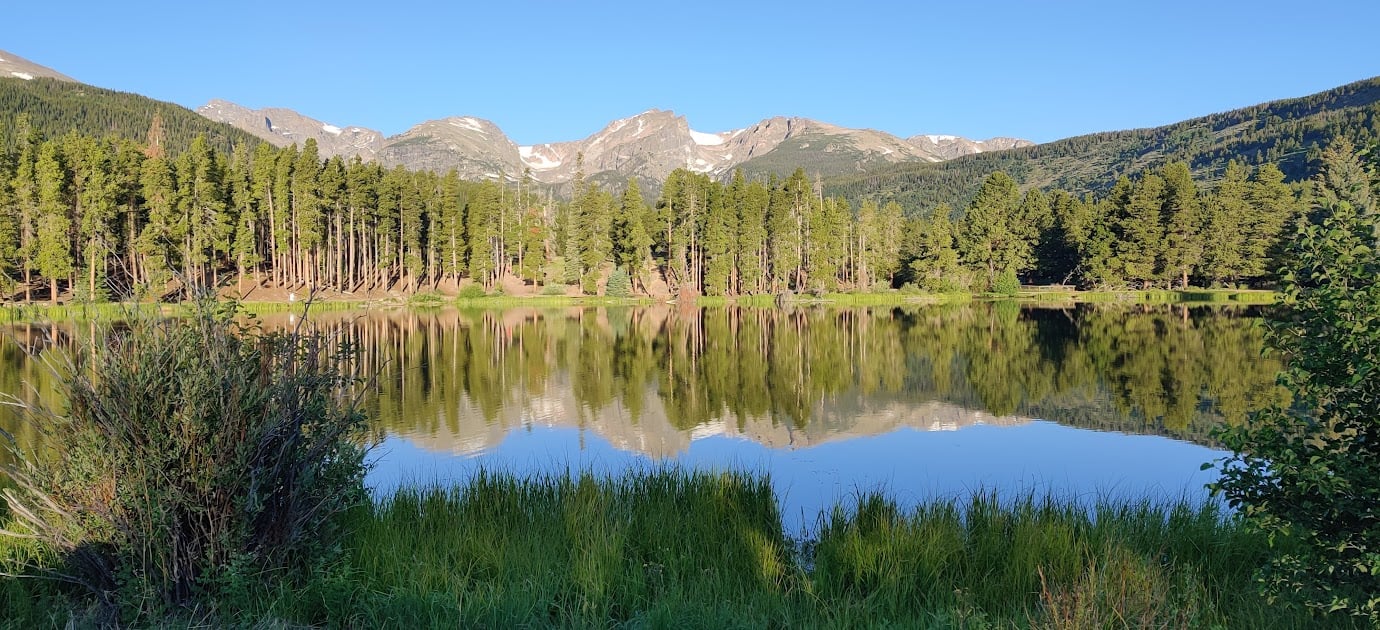

One of the most popular stops along Bear Lake Road is at Glacier Gorge. It has a small parking lot (which always seems to be full) and is a shuttle stop for Rocky Mountain’s shuttle service.
From the Glacier Gorge trailhead, you can hike to Alberta Falls in less than a mile, but you can also continue past Alberta Falls to Mills Lake, the Loch, Lake Haiyaha, and even Bear Lake and beyond. You can reach some of the highest alpine lakes in the area by following the trails beyond Alberta Falls. The trail will be crowded until you get to the falls but will become less so when you travel higher.
Hiking in the Bear Lake area is one of my favorite things! I love that there are several interconnected trails that you can choose your own adventure as you hike. You are often able to start your hike at one shuttle stop and then exit the hike at a different shuttle eliminating the need to backtrack.
The last time I visited, I started my hike at the Glacier Gorge shuttle stop, hiked to Alberta Falls, Lake Haiyaha, and Bierstadt Lake, and then caught the Bierstadt Lake shuttle back to the park and rode. I saw great variations of scenery of lakes and canyons, and had plenty of solitude too!
If crowds are not your thing (I don’t like them, actually), consider pushing a bit further to move beyond them on the trail. Check out the map in this piece for backcountry connections that could better give you some peace in the wilderness along the Bear Lake Corridor.
| Hikes from Glacier Gorge Trailhead | Distance | Level |
| Alberta Falls | 1.6 miles out and back | Easy |
| Mills Lake | 5 miles out and back | Moderate |
| The Loch | 5.4 miles out and back | Moderate |
| Lake Haiyaha | 6.95 miles out and back | Moderate |
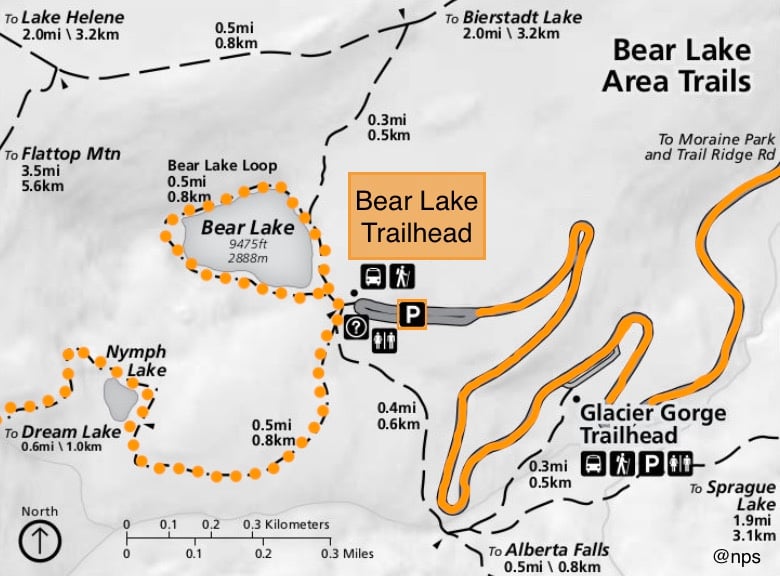


At the end of the drive up Bear Lake Road is Bear Lake itself. It was named by European settlers in the early 1900s who observed quite a few black bears in the area; today, you probably won’t see any bears – in fact, there are only about 18-20 bears in the entirety of Rocky Mountain National Park.
I love to recreate at Bear Lake in the winter when you can ice skate or snowshoe across the lake! But in the winter, the winds are fierce so watch for a still day if you can.
This beautiful sub-alpine lake has a handicapped-accessible trail surrounding it, with 30 numbered posts that correspond to an educational booklet published by Rocky Mountain Conservancy, Rocky Mountain’s nonprofit fundraising organization.
You can purchase this booklet when you arrive at Bear Lake, or one of the Conservancy’s stores at the Rocky Mountain visitor centers. This book coordinates with the numbered posts around the lake and will teach about the history, geology, flora, and fauna of the area and is geared toward children (although I love it, too!).
From Bear Lake, there’s the Emerald Lake Trail – a very popular hiking destination in Rocky Mountain. This trail passes two sub-alpine lakes (Nymph and Dream) before reaching Emerald Lake. There is also a turn-off for Lake Haiyaha from this trail. Most of these hikes can be looped with other hikes in the area if you’re looking for a longer hike.
This trail gains almost 800 feet in elevation in about two miles and is unpaved and rugged. From fall through early summer, I advise you to be prepared for icy trails which will make it difficult to hike this area without micro-spikes or crampons. I always carry these traction devices in my vehicle year-round, so that I can do any hike I’d like to, no matter what the conditions.
| Hikes from Bear Lake | Distance | Level |
| Bear Lake | 0.6 mile loop | Easy |
| Nymph Lake | 1 mile out and back | Moderate |
| Dream Lake | 2 miles out and back | Moderate |
| Emerald Lake Trail | 3.2 miles out and back | Moderate |
| Lake Haiyaha | 4.2 miles out and back | Moderate |



What if I can’t get a reservation for the Bear Lake Corridor on the days I am visiting?
For seven months of the year, reservations are not required to visit Rocky Mountain National Park – including the Bear Lake Corridor and a percentage of them are held back to be released at 7:00 pm the night before during peak season.
If you still can’t get one you will need to enter the Bear Lake Corridor before 5:00 am or after 6:00 pm. As I’ve explained above – these are the most beautiful times to visit the Bear Lake Corridor anyway!
When is the prettiest time of year to visit the Bear Lake Corridor?
In my opinion, autumn is the most beautiful time to visit the Bear Lake Corridor. Striking aspen leaves are not the only attraction: a wide variety of foliage turns colors ranging from bright yellow to deep purple. It’s truly breathtaking! Hiking through aspen leaves shimmering in the breeze makes soothing rustling sounds and berries ripen quickly on previously flowering plants.
The beauty of the changing season in the Rocky Mountains can best be experienced in the Bear Lake Corridor, but be aware that fall lasts a very short time in Rocky Mountain. If you want to see the leaves, plan your trip from mid to late September and hope that an early snowstorm doesn’t bring them all down before that!
Autumn is also when the elk rut occurs – dramatic scenes between bull elk and their harems are a big attraction to Rocky Mountain this time of year.
FIND OUT: The Best (and Worst) Times to Visit Rocky Mountain National Park



Is there cell phone reception in the Bear Lake Corridor?
No. Well, sometimes the higher you get, the better chance you have of picking up a little bit of reception, perhaps. Before you go into the Bear Lake Corridor, be sure to let someone know that you will be traveling in the wilderness without cell reception, the areas you plan to visit, and when you are expected back.
However, please understand that if you are taking shuttles to and/or through the area, missed connections can lead to delays. The best idea is to give yourself a large window of time to complete your day. I always say, “I’m going to the Park. Be back by dark.”
GPS works well and can be used to navigate hiking trails without cell reception (it works with satellite). Paper maps (including the ones I linked to in this piece) will keep you from getting lost, too.
Rocky Mountain is crowded!
Need a game plan to avoid the crowds? Check out our itinerary.
Most travelers want to visit the most popular sites and still avoid the crowds. We have a detailed itinerary that gives you a step-by-step game plan so you can get to the best places at the right times.
ROCKY MOUNTAIN TRIP PLANNER: To read or watch all of our content about Rocky Mountain National Park, check out our Rocky Mountain Homepage
THINGS TO DO: There is so much to do including hiking, swimming, and driving Trail Ridge Road and Bear Lake Road
GREAT CITIES TO STAY OR CHECK OUT: Discover where to stay when visiting or explore some amazing cities nearby including Estes Park where you can take a tour of the Stanley Hotel
KNOW BEFORE YOU GO: Find out about getting into Rocky Mountain without a reservation, if the park is too crowded, and all about altitude sickness
WATCH: Enjoy videos of gorgeous Rocky Mountain National Park while learning our best tips for visiting by watching our Rocky Mountain YouTube Playlist
This site is a participant in the Amazon Services LLC Associates Program, an affiliate advertising program designed to provide a means for sites to earn advertising fees by advertising and linking to Amazon.com. We are compensated for referring traffic and business to Amazon and other companies linked to on this site.
Receive weekly newsletters updating you on the Best of the West including: essential travel tips, park updates, stories, and our favorite things to see and do.